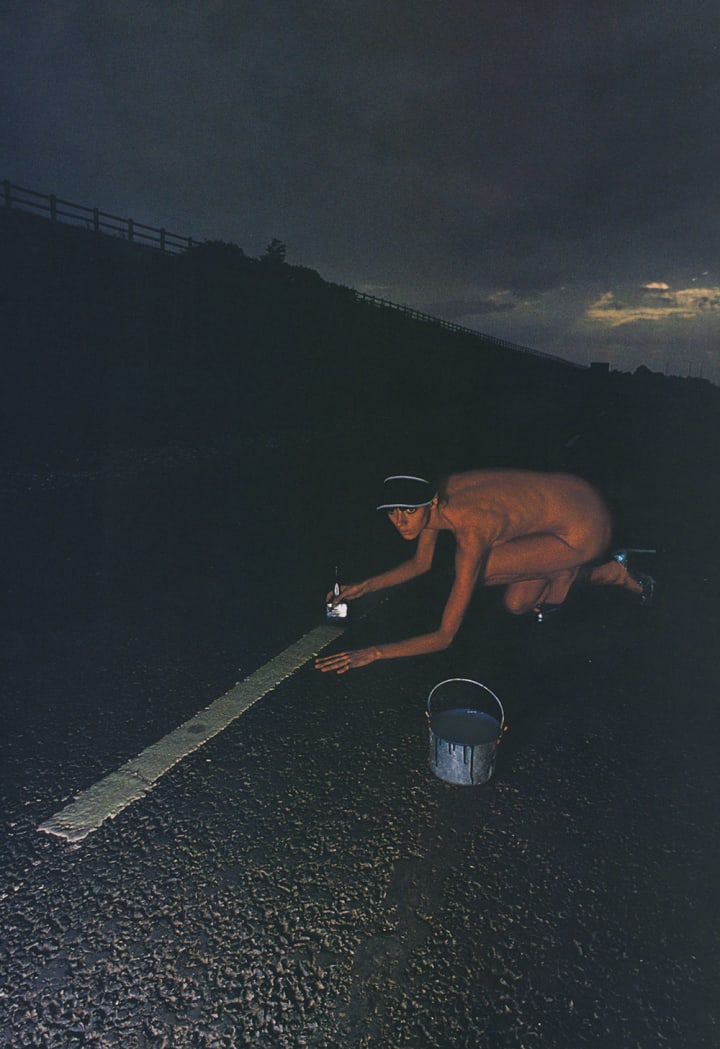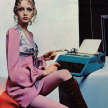John Thornton Erotic Photographer
Erotic photographer John Thornton is recognized for his love of women, use of color, and unique style.

John Thornton's work might be mistaken for that of Guy Bourdin or Helmut Newton, but under the scrutiny of self-transformation for which his composition and unique color sense have become the primary means of initiation, Thornton’s photographs conflate the social barriers that define our concepts of reality and fantasy. He is amused by the paintings of Magritte and fascinated by the work of engravers such as Dine, Hockney, Edwards, and Fallon. Thornton confesses to an absolute love of women (his favorite subject), of color ("I am incapable of seeing in black and white"), of electronic lighting ("My strobes have a total power output of 2,000 watt-seconds"), and of the good natural light of our old sun. He adds that his collection of lenses range from 20mm to 500mm, that he checks each pose with a Polaroid before shooting, and that he conceives of his photographs as fairy tales.
His photos were delivered in the fashion of an ordinary postal service, without comment, which is indicative of Thornton's extreme reticence in answering any questions about himself and his artwork. Reluctantly, he admits to having been born in Sydney, Australia on May 2nd 1946, where he attended Woolwich Primary School and then Hunters Hill High School. Of his academic experiences he says, "I was in Class F for fucking useless, they would not let me study art, that was for the brainy ones in Class A. Frankly, I wanted to be in Class G for Good for Nothing because they did basket weaving." Despite his frustration with the academic world, Thornton was able to study Technical Drawing, where he developed a talent that would later surface in his images.

Photo by John Thornton
Thornton's Early Days
Considering a future as a Naval Architect, Thornton landed his first job at the Cockatoo Island Dockyard, where he was able to embrace his interest in yachting on Sydney Harbor. He was introduced to his life long passion upon being hired as a photography assistant for Bruce Minnett’s Studio. It was here that Thornton would work under Howard Jones, Tom Tomney, and Stuart Emery. During this time he spent hours studying the images of Brassai, Man Ray, Edward Weston, and Karsh of Ottowa. He spent hours flipping through Spick & Span magazines and became wildly attracted to the sophistication and playfulness of the erotic photographs of women posing in stockings and suspenders. These experiences would develop the manner he conducted his work in, to render compositions that embody a confliction with the balance between boundaries and infinitude, or rather, composition and decomposition,
Those at Bruce Minnett’s Studio wrote to Thornton following his departure from Sydney, "You must get to a point when taking photographs, it must become instinctive, picking up maybe a 35mm, 4/4cm, 5"x4" camera, knowing that the camera and lens you have chosen will capture the image that you have seen." In South Africa, Thornton embraced his love of surf and set out to find the biggest wave he had yet to ride. The photographer survived by taking pictures on an old Pentax, and writing articles about surfing life. In Cape Town, Thornton partnered with Martin Gibbs to start Studio 5 in a small cottage near the ocean around Camps Bay. The two photographers shot fashion and advertising. For Thornton, it was not enough. He craved creativity and originality, which he brought into experimentation with the advertising and fashion content he was producing at the time. The work was so good that Thornton was kicked out of the advertising shoot after an executive deemed it too strange.
During the apartheid in South Africa, Thornton created the image The White Cop and Pretty Black Ida. The photograph contained a bold anti-apartheid theme and revealed a newspaper placard lying on the ground, bearing the same title of the photograph. One day Thornton decided to stencil the word CENSORED in white on his black friend, Toy. He did the same to his white friend’s back but this time it was stenciled in black. Not long after, Thornton gathered the few belongings he could take with him to London. He never returned to Cape Town.
He had met Richard Winslade in a darkroom during his stay in Cape Town. Upon moving to London, Thornton took up Winslade’s offer and slept on his floor in Notting Hill Gate for over three months. The two photographers processed and printed their work in Winslade’s bathroom, which they turned into a makeshift darkroom. Winslade introduced John to numerous London photographers until the latter moved to Lancaster Gate, an area populated by only 15 people. There he spent the majority of his time documenting the street vendors and nearby city parks.





Notable Works
The object of his photograph, Love In The House Of The Nobleman, is the nude body of a woman sitting down with a mask covering her face. The woman’s soft and organic form is juxtaposed with the hard lines of the modern architecture in the background. The subject is positioned in a fashion that simultaneously refuses to settle within the bounds of restraint and portrays the limitlessness of free motion. It is in this seemingly contradictory notion of the photograph that Thornton conveys his deep attraction to an instance of ordinary subjects conceiving raw and fantastical elements of the surreal fantasy that his work continually lures his viewers into.
This particular facet of Thornton’s vision is a photographic convention of his concern for communicating intensely overlapping emotion. The woman’s line of sight pierces beyond the confines of the frame. Along with the deep lines engraved in the wall that continue past the frame, the infinitude of linear movement is suggestive of Thornton’s interest in surreal eroticism, an interest that was inspired by the works of Salvador Dali, who once described Thornton’s work as "Magnifico...Fantastico." Perhaps an explanation for the fantastical elements of his work can be found in Thornton’s early photography.
No. 3. A Apple A Day Keeps The Doctor Away embraces the deceivingly simplistic black and white color scheme that would maintain a strong presence throughout his life. The image is a part of a sequence of four surreal photos. This specific photo demonstrates Thornton’s fascination with a surrealistic manifestation of food and body. The grinning apple is slightly elevated in the air as its teeth bite down on a snail that has made its way up another apple that sits below with a chunk bitten out of its body. The flat gray background leaves the viewer with no distractions and draws our attention to a question that is challenging for its surreal efforts. What is so scary about the doctor? This question poses the challenge of death and sickness. To what extent this question has roots in Thornton’s personal life remains unclear. Regardless, it is certain that the apple has become a form of surrendering ourselves to an acceptance of commonality in exchange for a pre-determined purpose: to live a long and healthy life.

Photo by John Thornton
Thornton's Style
Thornton’s true love, of course, was color itself. Thus the abundance of black and white photographs he has produced throughout his career contrast with his statement that he was incapable of seeing in black and white. Thornton’s fluency in an erratic assortment of visual languages is foregrounded in his black and white images. S&M Crow is one such image that would send Thornton’s work into a ripple of sequences between harsh and soft colors conveyed through the intensity of fire in the presence of a woman bearing suspenders and flailing her arms in the air. The theme of fire would carry on into his image Lady With The Lamp. The woman in this photo, holding a torch, is slightly out of focus and thus stands on the threshold of the nearby ancient European décor and real life. On the right side of the image the natural light divides the frame, as does the vantage point, which leads our line of sight into a bright backroom. The differing light contributes to the symmetrical composition of the architectural setting by texturizing the features of balance with decomposition. The image is one of many that suggest the elusive and, at times, misleading information Thornton provided to the public about his personal life and artistic preferences.
Nevertheless, John Thornton is a mystery for fellow artists and the public at large. His book Pipe Dreams reveals Peter Mayle’s (author of A Year in Provence, 1989) account of Thornton’s personal background. "John Thornton (if indeed that is his real name) was expelled from his native Australia many years ago for committing a smash and grab raid on a lingerie store in Sydney. He was apprehended while cramming one last suspender belt into his pocket and deported to South Africa." Others report that Thornton left Australia for South Africa to avoid being drafted into the Vietnam War, saying, "Fuck that for a game of soldiers." A rather unbelievable but nevertheless amusing account of Thornton believes he was discovered near Australia’s coastline on a raft constructed from bamboo and raised by Aborigines who then introduced him to photography. The differing accounts of Thornton’s personal background make us certain of the elusive and eccentric mysteries that surround the photographer’s life, which is most present in his fantasy-like reorientation of the world.
As he explored new dimensions of photography throughout his career, Thornton tested the limits of public persona. He deterred many attempts over the years to cement his self-image in the public eye in terms of tangible and intelligible characteristics. Thus, his work as a whole embodies the very spirit of Thornton himself by tackling the versatility of which his photography did.
Thornton works regularly with the biggest London advertising agencies and has received a number of awards, including the New York Art Directors Club Gold Award and the 6 Silver & Special Citations Design & Art Direction in London. Aside from his private collections throughout the world, Thornton’s photography has been exhibited in Tokyo’s Pentax Gallery, London’s Home House, Milan’s IL Diaframma Gallery, and Paris’s Nikon Gallery.
About the Creator
Filthy Staff
A group of inappropriate, unconventional & disruptive professionals. Some are women, some are men, some are straight, some are gay. All are Filthy.
Enjoyed the story? Support the Creator.
Subscribe for free to receive all their stories in your feed. You could also pledge your support or give them a one-off tip, letting them know you appreciate their work.






Comments
There are no comments for this story
Be the first to respond and start the conversation.